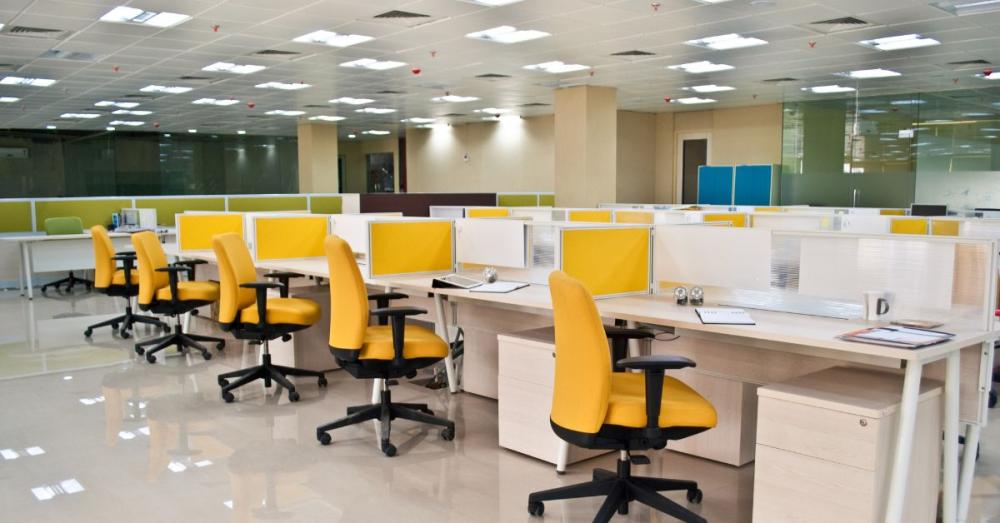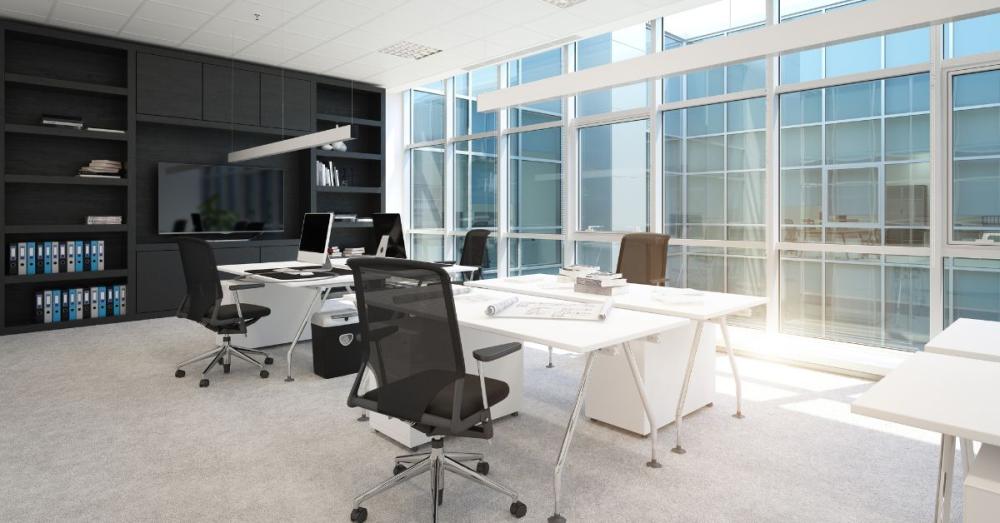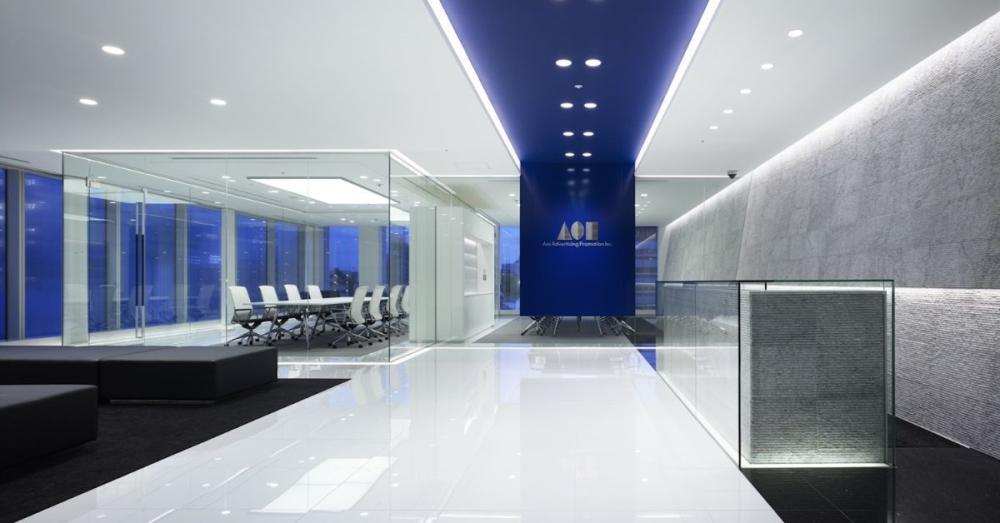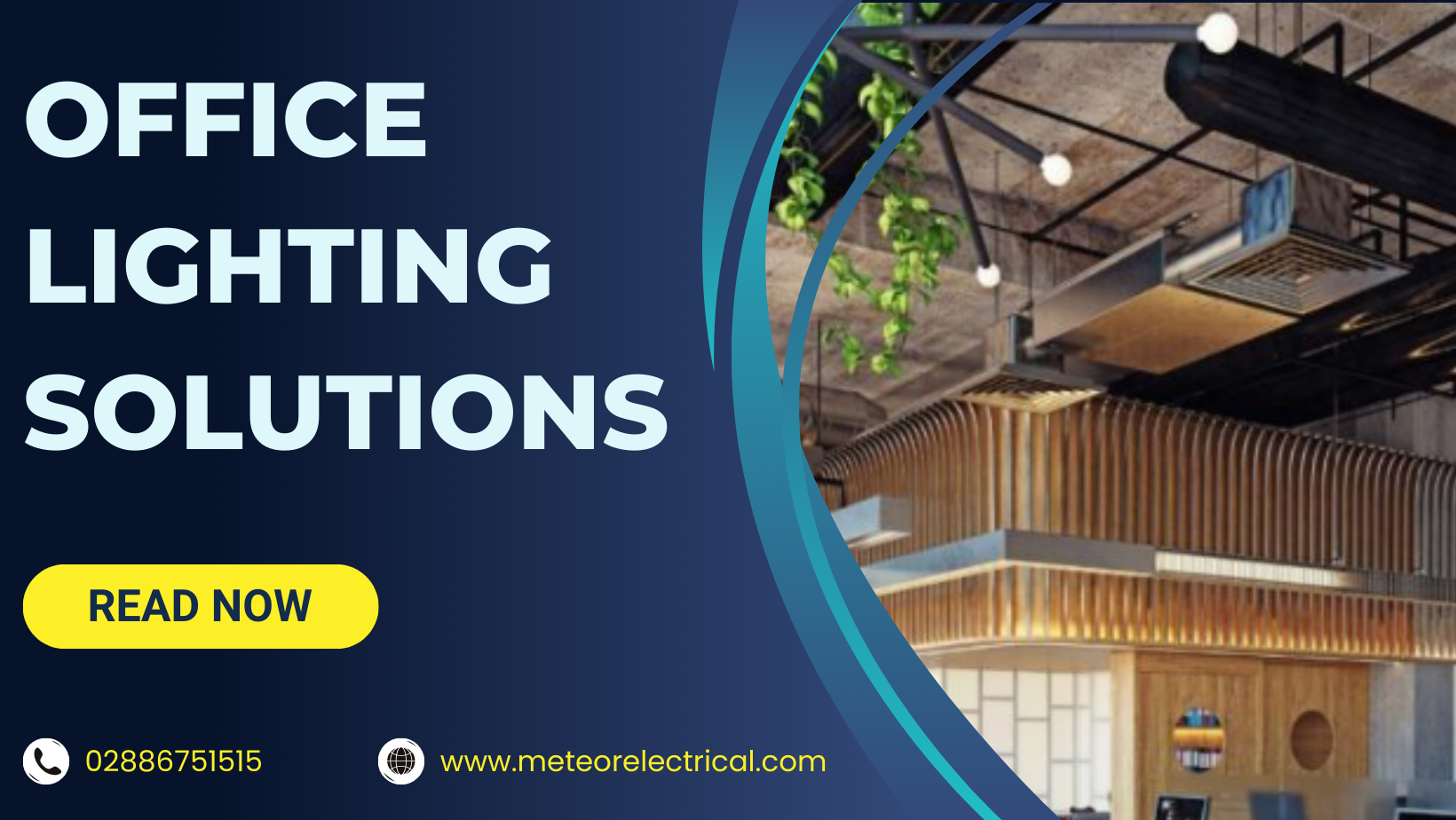Office Lighting Solutions
Office Lighting Solutions

A well-lit office isn’t just about visibility—it’s the cornerstone of a productive, energetic, and positive work environment. Lighting directly influences an employee’s productivity, energy levels, and mood. Poor lighting can lead to decreased performance and various health issues, making it crucial to meticulously plan your office lighting design.
Thankfully, the market is brimming with excellent office lighting solutions. From cutting-edge LED options to timeless traditional lamps, here’s everything you need to know to choose the perfect office lighting solution for your workspace.
Why Do You Need an Office Lighting Design?

Before diving into the myriad office lighting solutions available, it’s essential to understand why good office lighting is indispensable.
Boost Productivity and Well-being
Office lighting plays a pivotal role in maintaining a smooth-running workplace. Proper lighting enhances employee performance and elevates the aesthetic appeal of the workspace. After all, most people spend seven to ten hours a day in the office. Creating an attractive and comfortable working environment is crucial for ensuring that employees perform their best and feel at ease throughout the day. The Importance of Lighting in the Workplace outlines how lighting affects various aspects of work life, from concentration to overall satisfaction.
Ergonomics and Health
Good lighting is a fundamental component of office ergonomics, which refers to how people interact and perform in their work environment. Bright, high-quality lighting allows employees to focus better on their tasks, while poor lighting can lead to fatigue, headaches, and eye strain. According to Harvard Health, inadequate lighting can result in lower employee satisfaction and diminished work output, which can quickly deteriorate a business’s overall performance.
Energy Efficiency and Cost Savings
For business owners, balancing employee well-being with cost efficiency is paramount. Modern offices need lighting that doesn’t spike utility bills, and this is where LED office lighting shines. LEDs are highly energy-efficient, providing superior illumination while consuming minimal energy. Investing in energy-efficient lighting solutions like LEDs can lead to significant savings over time, as highlighted by Energy.gov.
Compliance with Standards

When designing your office lighting, it’s crucial to adhere to local lighting standards and regulations. These guidelines ensure that your workspace provides adequate illumination and maintains a safe working environment. Additionally, balancing artificial lighting with natural light can create a harmonious and productive atmosphere. Incorporating multiple lighting configurations, various light sources, colour temperatures, and appropriate illumination levels can cater to the diverse needs of your employees.
Enhancing Creativity and Mood
Different types of lighting affect not only productivity but also creativity and overall mood. Proper lighting can create an environment that fosters innovation and maintains high energy levels, while poor lighting can lead to a dreary and uninspiring workspace. When designing your office, consider how lighting can influence these aspects to create a more dynamic and effective work environment.
Credit: The Wall Street Journal
What Bulbs Are Used in Office Lighting?

Office lighting comes in a variety of options to suit different workplace needs. However, not all lighting solutions are suitable for every office space. The type of bulb used plays a significant role in determining the efficiency and effectiveness of your office lighting.
Incandescent Light Bulbs
Incandescent bulbs have been a staple in office lighting for over a century. These traditional bulbs feature a tungsten filament enclosed in a glass bulb. When electricity passes through the filament, it glows, producing light. However, incandescent bulbs are highly inefficient, as most of the energy is wasted as heat. This inefficiency leads to frequent bulb replacements and higher energy costs, making them less suitable for modern office environments.
If you still use incandescent bulbs, consider repurposing them for accent or task lighting rather than general illumination. However, for long-term energy savings and sustainability, switching to LED office lighting is highly recommended.
Compact Fluorescent Light Bulbs (CFLs)

Compact Fluorescent Lamps (CFLs) were once the go-to energy-efficient alternative to incandescent bulbs. CFLs use about 70-80% less energy and last significantly longer, often exceeding 8,000 hours of use. They operate at cooler temperatures, reducing the risk of heat damage and the need for frequent replacements.
CFLs work by passing electricity through a gas-filled tube, producing ultraviolet light that excites a fluorescent coating inside the bulb, emitting visible light. While CFLs were a major step forward in energy efficiency, they have their drawbacks. CFLs contain small amounts of mercury, making them hazardous to the environment and difficult to dispose of safely. Additionally, they can flicker, potentially causing health issues like headaches and eye strain.
For businesses aiming to adopt green office practices, LED lighting is a superior choice over CFLs due to its higher efficiency and eco-friendly profile.
LED Light Bulbs
Light Emitting Diodes (LEDs) represent the pinnacle of energy-efficient lighting technology. LEDs consume up to 90% less energy than incandescent bulbs and have a lifespan that can be up to 25 times longer. This longevity translates to fewer replacements and lower maintenance costs, making LEDs the preferred choice for modern office lighting.
LEDs are versatile, available in various configurations such as linear fluorescent or strip lights, and are ideal for both domestic and commercial applications. They provide high-intensity illumination with a wide angle, ensuring uniform lighting across the workspace without the excessive heat emission of incandescent or CFL bulbs.
Moreover, LEDs are environmentally friendly, as they do not contain harmful chemicals and can be easily integrated into green office initiatives. According to LEDs for Business, switching to LED office lighting not only enhances productivity but also contributes to substantial energy and cost savings.
What Are the Different Types of Office Lighting Fixtures?

While single luminaries can illuminate a workspace, specialised lighting fixtures designed for office environments offer enhanced functionality and aesthetic appeal. These fixtures are crafted to light up large spaces efficiently while maintaining an elegant design.
Suspended LED Office Lighting
Suspended lighting is a popular choice for office spaces due to its ability to provide ample illumination while adding a modern design element. These fixtures emit a soft, diffused light that can highlight specific areas within the office. By using multiple suspended luminaires, you can create distinct lighting zones tailored to different sections of your workspace.
Suspended LED office lights come in various shapes and sizes, including rectangular, round, oval, and square designs. They are easy to install and maintain, and their adjustable height feature allows customisation to fit various ceiling heights. For enhanced control, adding dimmer functions enables you to adjust the illumination levels according to your needs.
LED Flat Panel Light Fixtures

For those seeking bright and highly efficient illumination, LED flat panel lighting is an excellent choice. These overhead fixtures are installed behind ceiling panels, providing uniform lighting across the entire office space while keeping the fixtures discreet and out of sight.
LED flat panel lights are ideal for large workspaces or environments where minimal fixtures are preferred. They typically come in rectangular or square shapes, simplifying installation into existing ceiling grids. There are two main types of LED flat panels:
1. Edge-Lit Panels: These panels have a thin profile, with LEDs positioned along the edges of the frame. While they offer a sleek look, edge-lit panels tend to be more expensive and consume slightly more power.
2. Back-Lit Panels: In these panels, LEDs are placed behind the frame, allowing light to pass through a diffuser. Back-lit panels are generally more affordable and efficient, making them a popular choice for office lighting.
Choosing the right type of flat panel lighting depends on your office’s specific needs and budget. Both types offer high-quality illumination that can significantly enhance the workspace’s functionality and appearance.
Recessed Office Lighting
Recessed lighting is an excellent option for smaller office spaces where maintaining a clean and uncluttered ceiling is essential. LED recessed lighting fixtures are installed directly into the ceiling, creating a seamless look while providing focused, downward illumination.
These fixtures are perfect for creating lighting patterns that enhance the perception of space and provide concentrated light where it’s needed most. Recessed lighting can make a small office feel more spacious and bright, reducing the need for additional fixtures.
Additionally, some recessed LED fixtures come with adjustable lamps, allowing you to direct the light beam precisely where it’s needed. This flexibility is particularly useful in workstations or cubicles, giving employees control over their individual lighting environments.
How to Layer Your Office Lighting Solutions

Achieving optimal illumination in an office space requires more than just installing high-quality lighting fixtures. A well-thought-out lighting design that layers different types of lighting is essential for creating a balanced and functional workspace.
General or Ambient Lighting
General or ambient lighting provides the overall illumination for the entire office space. It sets the tone and ensures that the area is well-lit enough for people to move around safely and comfortably. Ambient lighting is typically achieved through overhead fixtures such as track lights, recessed pot lighting, chandeliers, or LED flat panels.
When selecting ambient lighting, aim for uniform illumination across the workspace to avoid dark spots or overly bright areas that can cause glare. In some cases, ambient lighting can also serve as task lighting, but it’s essential to ensure that it provides sufficient brightness for all general activities.
Task Lighting

Task lighting is crucial for specific work-related activities that require focused illumination. This type of lighting is localised and can be adjusted to meet individual needs, enhancing productivity and reducing eye strain. Common sources of task lighting include desk lamps, wall-mounted fixtures, pendant lamps, and under-cabinet lighting.
Effective task lighting should be bright enough to illuminate the work area without causing glare or shadows. Adjustable and controllable fixtures allow employees to customise their lighting according to their tasks, whether it’s reading, writing, or using a computer.
Accent Lighting
Accent lighting adds depth and dimension to the office space by highlighting specific features or objects, such as artwork, plants, or architectural details. While primarily used for aesthetic purposes, accent lighting can also contribute to a more inviting and inspiring work environment.
In an office setting, accent lighting can create focal points that break the monotony of a standard workspace, fostering creativity and enhancing the overall ambiance. However, it’s important to use accent lighting sparingly to avoid a cluttered or distracting environment.
Combining Lighting Layers
To create a cohesive and effective lighting design, it’s essential to combine these different lighting layers thoughtfully. Start with a solid foundation of ambient lighting, then add task lighting in work areas, and finish with accent lighting to highlight key elements of the office. This layered approach ensures that the workspace is not only functional but also visually appealing and conducive to productivity.
Credit: Nick Lewis
How to Layer Office Lighting Solutions

Now that you’re familiar with the various lighting options available for your office, it’s time to explore the concept of light layering. Layering involves using multiple light fixtures strategically to create a balanced and aesthetically pleasing environment. Here’s how you can master this technique:
Start with Ambient Lighting

Ambient or general lighting serves as the foundation of your office lighting design. It provides an even level of illumination throughout the space, ensuring that everyone can see comfortably without straining their eyes. Think of ambient lighting as the base layer that sets the overall brightness of your office.
Tips for Ambient Lighting:
- Choose LED Panels: LED panels are an excellent choice for ambient lighting as they offer uniform illumination without harsh shadows. They are energy-efficient and come in various sizes to fit different office layouts.
- Avoid Overly Bright Fixtures: Extremely bright lighting can cause discomfort, leading to squinting and headaches. Aim for a balanced brightness that illuminates the space without being overwhelming.
- Placement is Key: Distribute your ambient lighting evenly across the office to avoid dark spots. Consider ceiling-mounted fixtures or recessed lighting to maintain a clean and uncluttered look.
Add Task Lighting for Focused Areas
Once your ambient lighting is in place, it’s time to introduce task lighting. This layer focuses on specific areas where detailed work is performed, such as desks, reading nooks, and workstations. Task lighting enhances visibility and reduces eye strain, ultimately boosting productivity.
Effective Task Lighting Strategies:
- Desk and Reading Lamps: Equip each workstation with adjustable desk lamps or floor lamps. These allow employees to control the light direction, ensuring their immediate work area is well-lit.
- LED Strips: Incorporate LED strips under shelves or along desks to provide additional focused lighting. These are subtle yet effective in enhancing visibility for specific tasks.
- Smart Controls: Implement lighting controls that allow employees to adjust brightness levels according to their needs. This flexibility not only improves comfort but also contributes to energy savings.
Introduce Accent Lighting for Aesthetic Appeal
Accent lighting adds depth and dimension to your office space by highlighting architectural features, artwork, plants, or branding elements. This layer not only beautifies the workspace but also creates a more inviting and stimulating environment.
Ways to Incorporate Accent Lighting:
- Track Lighting: Use track lights to direct light toward specific areas or objects you want to highlight. This is perfect for showcasing artwork or design elements.
- Wall Sconces and Picture Lamps: Install sconces or picture lamps to draw attention to decorative pieces or company branding visuals. This adds a touch of elegance and personality to the office.
- LED Spotlights: Focus LED spotlights on plants or feature walls to create focal points that break the monotony of a standard workspace.
Office Lighting Solutions Comparison
| Lighting Layer | Type of Fixture | Features | Best Uses |
|---|---|---|---|
| Ambient | LED Panels, Recessed Lighting |
|
|
| Task | Desk Lamps, LED Strips, Adjustable Lighting |
|
|
| Accent | Track Lighting, Wall Sconces, LED Spotlights |
|
|
| Natural Light Integration | Skylights, Light Tunnels, Reflective Surfaces |
|
|
General Layering Guidelines
To ensure your lighting design is both functional and visually appealing, keep these guidelines in mind:
- Understand Your Office Activities: Different areas of your office serve different purposes. For example, creative brainstorming zones might benefit from warmer lighting to stimulate creativity, while areas requiring high focus should have cooler, brighter lighting.
- Use Dimmer Switches: Installing dimmer switches allows you to adjust the brightness of ambient lighting, providing greater control over the office environment.
- Choose the Right Colour Rendering Index (CRI): High CRI bulbs ensure that colours appear more vibrant and true-to-life, which is essential for tasks that require colour accuracy.
- Mimic Natural Light: In break rooms and cafeterias, use lighting that mimics natural daylight to create a welcoming and cozy atmosphere. This can help employees feel more relaxed and rejuvenated during breaks.
- Indirect Lighting: Opt for indirect lighting solutions to minimise glare and reduce harsh shadows. Lampshades on desk lamps or floor lamps can help scatter light more evenly across the workspace.
What Is the Best Colour Temperature for Office Lighting Solutions?

Colour temperature plays a crucial role in how lighting affects the ambiance and functionality of your office. Measured in Kelvin (K), colour temperature describes the appearance of light, ranging from warm yellowish tones to cool bluish hues. Choosing the right colour temperature can enhance both productivity and comfort in your workspace.
Understanding Colour Temperature
- Warm White (2700K - 3000K): These bulbs emit a cozy, yellowish light ideal for creating a relaxed and inviting atmosphere. They are perfect for break rooms, cafeterias, and areas where employees unwind.
- Cool White (3500K - 4100K): Offering a more neutral, white light, cool white bulbs are suitable for general office areas. They provide clear visibility without being too harsh, making them versatile for various tasks.
- Daylight (5000K - 7000K): Mimicking natural daylight, these bulbs emit a bright, bluish-white light that enhances alertness and focus. They are ideal for areas where high concentration and detailed work are required, such as conference rooms and design studios.
Choosing the Right Colour Temperature
When selecting colour temperatures for your office lighting, consider the following:
- Functionality: Determine the primary activities in each area of your office. High-focus tasks benefit from cooler temperatures, while creative and relaxation zones thrive under warmer lighting.
- Natural Light Integration: If your office has ample natural light, balance it with artificial lighting that complements the daylight spectrum. For spaces with limited natural light, opt for higher colour temperatures to simulate natural illumination.
- Employee Preferences: Allow flexibility in lighting controls so employees can adjust the colour temperature to their liking. Personalised lighting can improve comfort and satisfaction, leading to increased productivity.
Important Guidelines to Follow for Office Lighting Solutions

Creating a positive and safe working environment extends beyond aesthetics. Proper office lighting is essential for employee health, safety, and overall well-being. Here are some key guidelines to ensure your lighting solutions meet these standards:
Credit: Lighting Research Center
Adhere to Health and Safety Standards
Good lighting is vital for maintaining visibility and reducing workplace hazards. Follow these guidelines to ensure your office lighting complies with health and safety regulations:
- Sufficient Illumination: Ensure that all areas, especially workstations and common spaces, are well-lit to prevent accidents and promote productivity.
- Even Light Distribution: Avoid creating overly bright spots or deep shadows. Uniform lighting reduces eye strain and enhances comfort.
- Glare Reduction: Position light fixtures to minimise glare on screens and reflective surfaces. Use diffusers or shades to soften intense light sources.
The Workplace (Health, Safety, and Welfare Regulations 1999 lists several points and parameters to ensure sufficient lighting in the workplace. This act highlights that employers and people in control of lighting should ensure no health risks to employees and anyone else using the office premises. Here are some ways you can instill positive lighting guidelines in an office space.
Consider Ergonomics

Lighting is a fundamental aspect of office ergonomics, which focuses on optimising the workplace to fit the needs of employees. Proper lighting design can prevent physical discomfort and enhance work performance.
- Adjustable Lighting: Provide lighting fixtures that can be adjusted to suit individual preferences and tasks. Adjustable desk lamps and dimmable overhead lights offer personalised control.
- Task-Specific Lighting: Tailor lighting solutions to specific tasks. For instance, detailed work requires brighter, focused lighting, while general tasks benefit from softer ambient lighting.
Optimise Energy Efficiency
Sustainable lighting solutions not only reduce your environmental footprint but also lower operational costs. Implement the following strategies to enhance energy efficiency in your office lighting:
- Switch to LED Lighting: LEDs are the most energy-efficient lighting option available. They consume less power, last longer, and produce less heat compared to traditional bulbs.
- Utilise Natural Light: Maximise the use of natural daylight to reduce reliance on artificial lighting. Design your office layout to allow ample sunlight, and use window treatments that control light without blocking it entirely.
- Install Smart Controls: Use automated lighting systems, such as motion sensors and programmable timers, to ensure lights are only on when needed. This reduces energy waste and prolongs the lifespan of your fixtures.
Maintain Proper Lighting Maintenance
Regular maintenance ensures that your lighting system remains effective and efficient. Follow these maintenance tips to keep your office lighting in top condition:
- Routine Cleaning: Dust and debris can accumulate on light fixtures, reducing their efficiency. Schedule regular cleaning to maintain optimal light output.
- Timely Repairs: Address any issues with your lighting system promptly. Replace faulty bulbs, fix wiring problems, and update outdated fixtures to prevent further complications.
- Periodic Audits: Conduct lighting audits to assess the performance of your lighting system. Identify areas that need improvement and make necessary adjustments to enhance functionality and efficiency.
Final Takeaway
Investing in the right office lighting solutions is more than just a design choice—it’s a strategic decision that impacts employee well-being, productivity, and overall business success. By layering your lighting with ambient, task, and accent elements, you create a dynamic and comfortable workspace tailored to your team’s needs.
Key Points to Remember:
- Layer Your Lighting: Combine ambient, task, and accent lighting to achieve a balanced and functional office environment.
- Choose the Right Colour Temperature: Select colour temperatures that align with the specific activities and areas within your office.
- Follow Health and Safety Standards: Ensure your lighting design promotes safety, reduces glare, and prevents eye strain.
- Optimise Energy Efficiency: Use LED lighting, maximise natural light, and implement smart controls to save energy and reduce costs.
- Maintain Your Lighting System: Regular cleaning, timely repairs, and periodic audits are essential for sustaining an effective lighting setup.
By thoughtfully designing your office lighting, you not only enhance the aesthetic appeal of your workspace but also create an environment that supports your team’s productivity and well-being. Embrace the power of layered lighting solutions and watch your office transform into a brighter, more efficient, and inspiring place to work.
Frequently Asked Questions (FAQs)
1. What are the benefits of using LED office lighting?
LEDs are highly energy-efficient, reducing electricity costs by up to 90%. They have a long lifespan, lasting up to 25 times longer than traditional bulbs, and provide excellent light quality with adjustable colour temperatures. Additionally, LEDs are eco-friendly, containing no harmful chemicals.
2. How do I choose the right colour temperature for my office?
Choose warm white (2700K-3000K) for relaxed areas like break rooms, cool white (3500K-4100K) for general workspaces, and daylight (5000K-7000K) for areas requiring high focus, such as conference rooms and workstations. Consider the activities and ambiance you want to create in each space.
3. How can I maximise natural light in my office space?
Optimise window placement by arranging desks near windows, use light-coloured walls and reflective surfaces to bounce light around, and install skylights or light tunnels in areas with limited window access. Sheer window treatments can help diffuse harsh sunlight while maintaining brightness.
4. What are the key considerations for layering office lighting?
Combine ambient, task, and accent lighting to create a balanced environment. Ensure even light distribution, minimise glare, choose appropriate colour temperatures, and incorporate adjustable controls like dimmers to cater to different needs and activities within the office.
5. How can smart lighting solutions save energy and costs in an office?
Smart lighting systems use features like motion sensors, automated controls, and programmable timers to ensure lights are only on when needed. This reduces energy waste, lowers utility bills, and extends the lifespan of lighting fixtures by preventing unnecessary usage.

